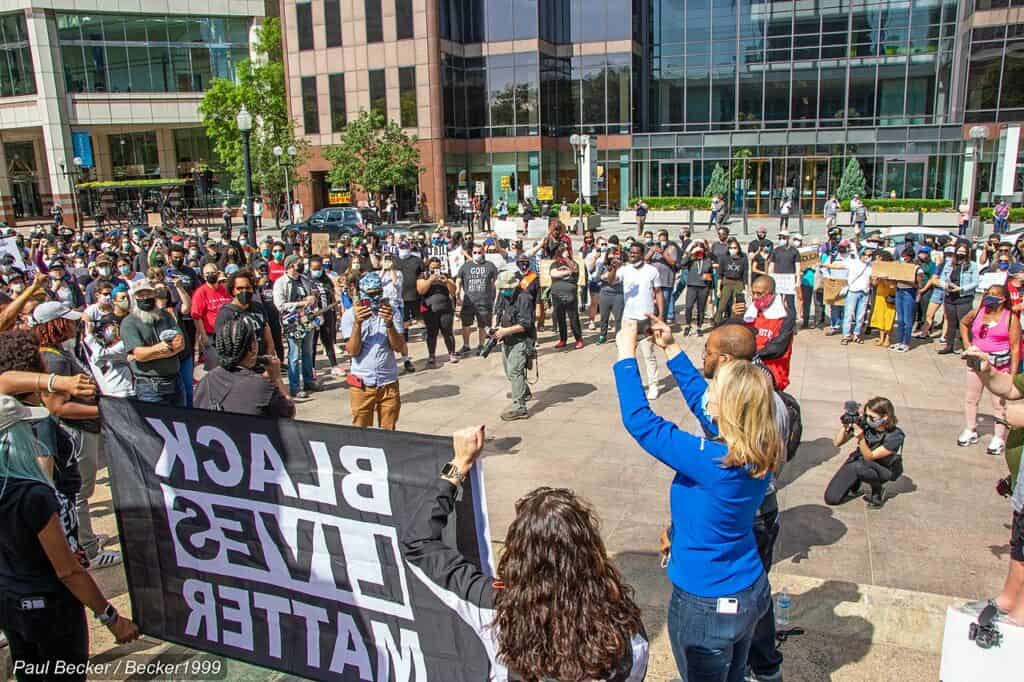Response to Kimberlee A. Johnson’s Presentation at December 1, 2021 Colloquium
Part of Educating Urban Ministers in Philadelphia After 2020 project
The murder of George Floyd was a catalytic event within modern American history. When it comes to the progress of civil rights within the American social landscape, the murder of Floyd coupled with the national and international response represents a shift in the public awareness of various elements of white supremacy. Awareness does not necessarily mean change, but it is progress. Dr. Kimberly Johnson in her paper, “The Impact of George Floyd’s Murder on the Church,” tackles the subject matter with skill and an awareness of how this pivotal event creates a ripple through the various levels of our social strata. She brings to the forefront very quickly the different responses to this very American tragedy, a lynching tragedy.
Dr. Johnson spotlights the responses that would come from local Philadelphia communities of faith–which generally represent the church’s response to Black death at the hands of the authorities. The three responses; “silence, dissonance and action”1 not only represent Philadelphia churches, but they also represent the historical responses from the church and broader still the people of God throughout biblical history.
The absence of a historical narrative leaves Floyd’s death as a tragedy, but as Dr. Johnson intimates in her paper, this pivotal event cannot and should not be divorced from the broader lens of history. Against the backdrop of the trilogy of the church’s silence, dissonance and action, she highlights that Floyd’s death came on the heels of Breonna Taylor’s and Ahmaud Arbery’s unjust state sanctioned executions, or as Dr. Johnson labels it, “lynchings.” Her use of “lynching” was accurate as it appropriately labels what occurred, a “public spectacle,” as theologian James Cones defines it in his book, The Cross and the Lynching Tree.2
Johnson provided ample proof of Philadelphia church involvement in the efforts to address systemic racism within law enforcement and the judicial system. It was encouraging to hear of the work of POWER Interfaith and their ability to immediately respond to injustice and also the key location at the City Hall Octavio Catto statue to call for a redress of the right to life, liberty and the pursuit of happiness.3 Dr. Johnson’s decision to highlight where the gathering had been positioned was significant because in Philadelphia one might presume that Independence Hall or the Liberty Bell might be an appropriate location, but it highlights the problematic relationship that we have in this country around the subject of systemic injustice as it relates to our founding documents and founders.
While reading Dr. Johnson’s words there was yet another point of connection as she shared her visceral response during a Zoom meeting with colleagues following the Floyd lynching and the subsequent uprisings happening across many American cities. She stated that there was “silence” from white co-workers, not a word or acknowledgement. I knew her pain because I and many other African American Christians have been in white space and have heard the silence, loud and clear– it communicated all that we needed to know about the state of race in this country. She placed the following words in succession to describe her response, “Awkward. Insensitive. Lacking in awareness and empathy. Downright infuriating.”4 These are words that are from the heart and accurately capture the rollercoaster of emotions that arise from trying to thrive within a system permeated with inequality and injustice. Johnson’s words were backed up by what researchers at the Pew Research Study reported regarding the disparity around racial justice sermon topics within white evangelical and Black Protestant churches.5 Negligence of the topic from the pulpit contributes to the lack of concern in the pew.
Dr. Johnson did not frame the narrative as totally without hope. She provided some encouraging numbers when she declared the following regarding a small sampling of area Christian churches:
- 72.7% indicated that Floyd’s murder led them to having more discussions about criminal justice or racial justice issues,
- 72.7% hosted or participated in educational forums, and
- 45.5% began to explore anti-racism.6
This is encouraging news about Philadelphia churches and if this sampling of the local Christian community is true of the nation, then the collective church in America is in good shape regarding issues of racial injustice. While these numbers are encouraging and the number of clergy and religious leaders listed in Dr. Johnson’s paper was equally encouraging, I do not believe that it accurately represents the willingness of the broader Western Evangelical/ Protestant church to go after the matter of racial justice and/or racial equality in light of George Floyd’s public lynching.
In the reviewer’s estimation, the crux of Dr. Johnson’s efforts in this piece is found in the following statement, “Theological institutions constrained to equip God’s servants for service in this world must be attuned to the call for church leaders to provide Spirit-led and contextualized ministry.”7 Johnson highlights church leaders, as we know full well, as the primary target for institutional religious education. Leaders are the unique catalysts for change on the ground. Leaders marched, prayed, held vigils, produced workshops, did safe space forums, walked, held sit-ins, and outdoor gatherings where bull horned declarations and demands were given to anyone who would listen. The reviewer believes that the industry of religious training may be missing the opportunity to not only train the leaders, but also to train the person in the pew.
There is the positive aspect of having leaders willing and ready to lead their congregations to change, but what about those leaders who are conditioned to remain stagnant or silent in the face of a human being enduring public execution? Dr. Johnson draws on Jemar Tisby and his book, The Color of Compromise: The Truth About the American Church’s Complicity in Racism. He says the following, “When it comes to racism, the American church does not have a “how to” problem but a “want to” problem. Given ten minutes, a pen, and paper, most American Christians could come up with a list of ways to increase racial equity in our congregations and communities.”8
Johnson provides eight ways of pushing the Floyd movement into a shift in how theological education is carried out in the Philadelphia region. She gives a list of practical as well as philosophical suggestions that can be undertaken by institutions to ensure that leaders are equipped to push for change within systems. Her list is comprehensive–she leaves very little meat on the bone and so there is not a lot to add, but I would like to suggest an addendum to her list.
If a seminary is committed to reach the region and not simply training regional leaders around racial justice, then it must reach both the clergy and laity. How does the theologically informed participate in discipling the region? In many ways getting to laity may be easier than we thought possible. Consider the accelerated push towards digital gatherings as well as multidimensional digital delivery mechanisms. Things like YouTube videos that are readily available for the laity, podcasts, short blogs and vlogs in everyday language makes the conversation accessible to those who exist in the pew and will never step into a seminary. This is a both/and approach and not an either/or approach.
In conclusion, Dr. Kimberly Johnson provides the Christian community with an additional path forward. It has been an honor to review her essay and, in particular, her work to showcase the network of Christian leaders committed to working for racial justice. She poignantly draws a straight line from the public lynching of George Floyd to the movement towards a justice-informed Delaware Valley church community.
Notes
1 Kimberlee A. Johnson, “The Impact of George Floyd’s Murder on the Church,” Journal of Urban Mission, 8 no. 2 (December, 2022), https://jofum.com/articles/the-impact-of-george-floyds-murder-on-the-church/.
2 James H. Cone, The Cross and the Lynching Tree (Maryknoll: Orbis Books, reprinted 2013).
3 POWER Philadelphia, October 18, 2021, accessed November 21, 2021, https://powerinterfaith.org/power-philadelphia/.
4 Johnson, “Impact of George Floyd’s Murder.”
5 Besheer Mohamed and Kiana Cox, “Before Protests, Black Americans Said Religious Sermons Should Address Race Relations,” Pew Research Center, June 15, 2020, https://www.pewresearch.org/fact-tank/2020/06/15/before-protests-black-americans-said-sermons-should-address-race-relations/.
6 Johnson, “Impact of George Floyd’s Murder.”
7 Ibid.
8 Jemar Tisby, The Color of Compromise: The Truth About the American Church’s Complicity in Racism (Grand Rapids: Zondervan, 2020), 213.

